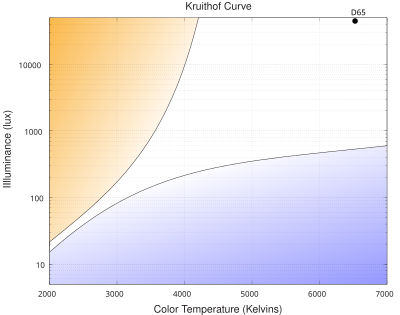TranceAddict
Newly Enlightened
[h=1]Kruithof curve[/h]

Named after the Dutch physicist Arie Andries Kruithof,[2] the Kruithof curve relates the illuminance and colour temperature of visually pleasing light sources. Lighting conditions lying inside the bounded region were empirically assessed as being pleasing, whereas conditions outside the region were displeasing.
The colour sensation of a given light mixture may vary with absolute luminosity, because both rods and cones are active at once in the eye, with each having different colour curves, and rods taking over gradually from cones as the brightness of the scene is reduced. This means, for example, that light with a colour temperature of 6000 K may appear white under highluminance, but appear bluish under low luminance. Under the same low luminance conditions, the colour temperature may need to be adjusted to, say, 4700 K, to appear white. This effect leads to a change in colour rendition with absolute illumination levels that can be summarised in the empirical Kruithof curve.[3]
As the brightness of the scene decreases, the brightness of red colours decreases more rapidly than those of blue colours, this being the Purkinje effect.
[url]http://en.wikipedia.org/wiki/Kruithof_curve
http://en.wikipedia.org/wiki/Purkinje_effect[/URL]

Named after the Dutch physicist Arie Andries Kruithof,[2] the Kruithof curve relates the illuminance and colour temperature of visually pleasing light sources. Lighting conditions lying inside the bounded region were empirically assessed as being pleasing, whereas conditions outside the region were displeasing.
The colour sensation of a given light mixture may vary with absolute luminosity, because both rods and cones are active at once in the eye, with each having different colour curves, and rods taking over gradually from cones as the brightness of the scene is reduced. This means, for example, that light with a colour temperature of 6000 K may appear white under highluminance, but appear bluish under low luminance. Under the same low luminance conditions, the colour temperature may need to be adjusted to, say, 4700 K, to appear white. This effect leads to a change in colour rendition with absolute illumination levels that can be summarised in the empirical Kruithof curve.[3]
As the brightness of the scene decreases, the brightness of red colours decreases more rapidly than those of blue colours, this being the Purkinje effect.
[url]http://en.wikipedia.org/wiki/Kruithof_curve
http://en.wikipedia.org/wiki/Purkinje_effect[/URL]

